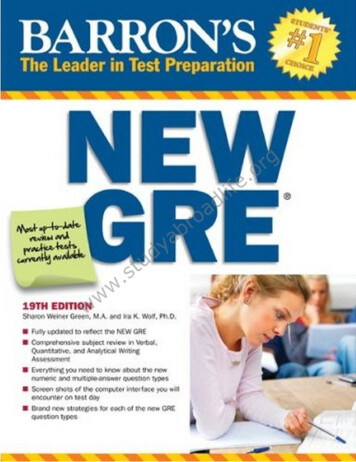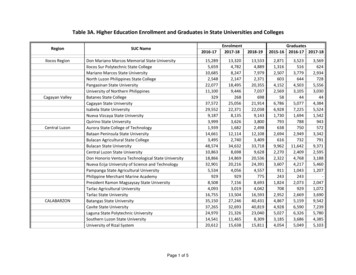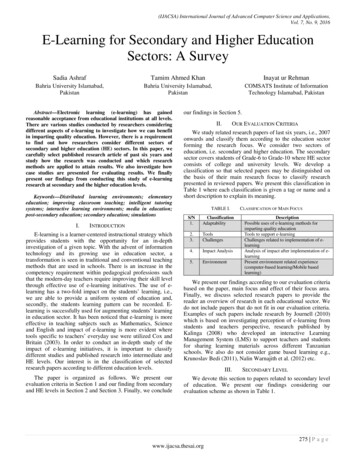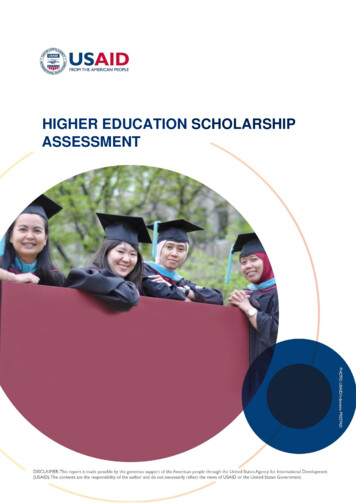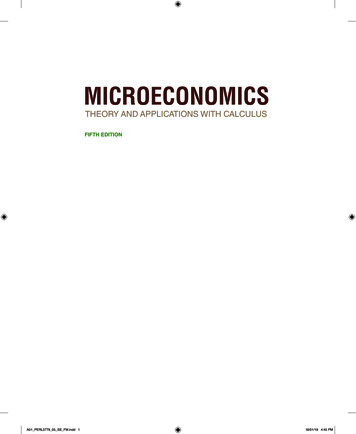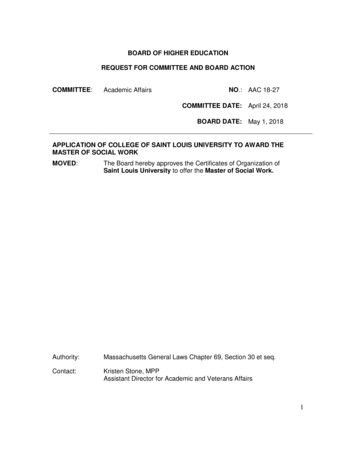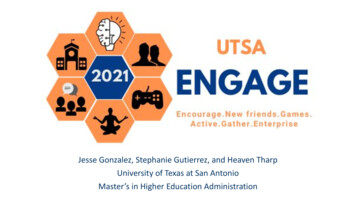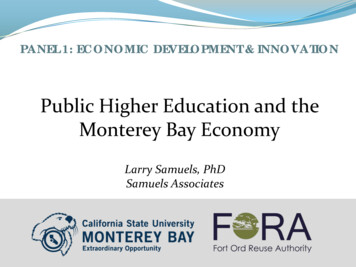
Transcription
CHAPTER 2HIGHER EDUCATION INMID 19TH AND EARLY 20TH CENTURY AMERICAIn the United States, the start of the second half of the 19th century was an erawhen few instructors in academic institutions held advanced degrees, such as Master ofArts, Master of Science, or Doctor of Philosophy. This was simply because few academic institutions in America awarded advanced degrees. America’s academic institutions were in their infancy, with many of the early colleges being established by variousreligious denominations, for the primary purpose of training men for the ministry. Consequently, the great majority of instructors at these early academic institutions weremen, and predominantly clergymen. During this time, other than the ministry, the twomost commonly chosen professions requiring any type of an academic education weremedicine and law.Scattered primarily in the States east of the Mississippi, these early academic institutions consisted of mostly small colleges that provided a limited undergraduate curriculum with a primary focus on the liberal arts and religious studies. The students, predominantly young men of wealthy families, were offered an education in the classics, whichincluded Greek, Latin, ethics and rhetoric, ancient history, geometry, logic and music.Markedly absent from the vast majority of these early colleges was any course in astronomy, biology, chemistry, geology, zoology or any other natural sciences.1Also, markedly absent from the vast majority of these early colleges were female students. Before the second half of the 19th century, women in this country had limited access to the higher education offered at American colleges. It was not until the late 19thand early 20th century that increasing numbers of this nation’s colleges began to acceptwomen. Those young women able to extend their education beyond grammar school,attended a female academy, seminary, or a state normal school where they were most of29Chautauqua: The Nature Study Movement in Pacific Grove, CaliforniaDonald G. KohrsCopyright 2015
ten trained as elementary and secondary schoolteachers. In fact, during the late 19thcentury and into the early 20th century, a majority of the students attending normalschools - educational institutions whose main purpose was to train schoolteachers andestablish teaching standards (i.e. norms) - were women. Enrollment numbers from theCalifornia State Normal School at San Jose show just how dominant the attendance ofwomen at a state normal school could become.2YearEnrollmentPercentage of 2.61904-190560893.41909-191061996.3During this period in American history, women who attended these educational institutions did not focus on the classics but, in sharp contrast to their male counterparts,were often trained in the natural sciences.3 Beginning in the last quarter of the 19thcentury and into first quarter of the 20th century, instruction in natural history andlaboratory science became an important component of the curriculum of normalschools. As a result, practically every normal school in America included botany, geography, nature study, and physiology. Beyond these courses many normal schools had required curricula that included one or more of the following subjects: astronomy, biology, chemistry, geology, mineralogy, and physics.4The California State Normal School at San Jose, for example, provided an extended curriculum of courses in natural history and sciences, and in addition, possessed a natural history museum and a herbarium.5 The museum featured cases hold30Chautauqua: The Nature Study Movement in Pacific Grove, CaliforniaDonald G. KohrsCopyright 2015
ing specimens in conchology, including a collection of over three thousand specimensof West Coast shells provided by an amateur conchologist, Mr. Henry Hemphill, and acollection of more than fifteen hundred rare California and foreign shells provided byMiss Jennie R. Bush. Other branches of natural history were well represented withinthe museum by twenty cases of minerals, thirty cases of insects, two cases of crustaceans and radiates, one case of California tertiary fossils, one case of Silurian fossils,and two cases of foreign and native woods.6 A herbarium, gathered through years of effort by Miss Mary EB Norton, the instructor of botany, contained several thousandplants, among them representative species from each continent. Each plant specimenwas carefully classified, labeled, and arranged in its case. The aim of the CaliforniaState Normal School at San Jose was to make this museum collection useful and instructive, as opposed to just a display to satisfy simple curiosity.7Beyond the museum and herbarium, the California State Normal School at San Josemaintained a chemistry laboratory, complete with the necessary equipment for experimental work by the students. In the case of chemistry and physics, the students themselves manufactured much of the equipment used, which better prepared them forteaching elementary science in the rural communities of California. The school wasequipped with microscopes for the study of botany, physiology, and zoology.8 For astronomical studies, although the Normal School did not have an observatory on the campus in San Jose, each senior was allowed use of the large telescope at the Lick Observatory during annual trips up Mount Hamilton.9This emphasis on the natural sciences at the California State Normal School prepared women to become qualified science teachers, primarily at the elementary schoollevel, given that there were far more grade school than high school teaching positions,especially in rural countryside of California during the later years of the 19th century.1031Chautauqua: The Nature Study Movement in Pacific Grove, CaliforniaDonald G. KohrsCopyright 2015
Lick Observatory, Mount Hamilton, California.Detroit Photographic Company, c1902.Photograph courtesy of the Prints and Photographs Division, Library of Congress.Number: LC-DIG-ppmsca-1797432Chautauqua: The Nature Study Movement in Pacific Grove, CaliforniaDonald G. KohrsCopyright 2015
ELEMENTARY EDUCATION INMID 19TH AND EARLY 20TH CENTURY AMERICAIn the United States, during the second half of the 19th century, the majority ofAmerica’s children attended one-room school houses where the teachers were predominantly young women.11 Just how disproportionate women were as schoolteachers in thefar reaches of the West is exemplified in the County of Monterey, California, where inthe year 1900, the school system was divided into 101 school districts employing 125female teachers and 10 male teachers. Based on those figures, the Monterey Countyschool system was dominated by one-room schoolhouses with women making up 93%of the schoolteachers, primarily engaged in elementary education.12During this period in American history, the majority of these female instructors inelementary schools did not hold advanced degrees in education or teaching credentialsfrom accredited academic institutions. Most were in their teens or early twenties, withmany having little or no education beyond the eighth grade.13 As a result of this virtually complete lack of training in pedagogy, teaching was based almost entirely on repetition and memorization. This method of instruction had children reading and recitingfrom textbooks until they knew large portions of the material by heart.14 With William McGuffy’s Eclectic Reader being the most common textbook of the 19th century,there were eleven-and twelve-year-old children who had memorized and could recite200 or even 300 pages of the McGuffy Reader practically word for word.15 Other children, whose only opportunity to obtain any schooling was limited to their attendanceof Sunday school, were provided an education through the memorization ofscripture.16 One such student, who first learned by rote learning of the scripture, wasthe famous California naturalist John Muir, who by age eleven had memorized muchof the Bible and could recite the entire New Testament and most of the Old Testament verbatim .17 In sharp contrast to learning through memorization and recitation,33Chautauqua: The Nature Study Movement in Pacific Grove, CaliforniaDonald G. KohrsCopyright 2015
the method of study that Louis Agassiz wished to introduce into the American educational system was one that encouraged using textbooks together with objects of nature.34Chautauqua: The Nature Study Movement in Pacific Grove, CaliforniaDonald G. KohrsCopyright 2015
LOUIS AGASSIZ’S METHOD OF STUDYLouis Agassiz’s method of study was one that encouraged students to develop theircritical thinking abilities through a combination of inquiry-based observation and a direct “hands-on” approach to learning. His method of teaching natural history encouraged a spirit of investigation, while developing the faculties of observation, critical reasoning, and independent thinking. Agassiz, in his own words, describes his teachingtechnique, and how this pedagogical approach differed from the dominant method ofthe late 19th and early 20th century, that of continual recitation and memorization:Our school system has been developed in a manner which has produced the most admirable results,and is imitated everywhere as the most complete and the most successful; but, while we have attainedthe highest point in that respect, we are also best prepared by that very position to make any further improvement which may lead to a better future. And I believe that the introduction of the study of naturalhistory, as a branch of the most elementary education, is what can be added to what is already so admirable a system. The difficult art of thinking can be acquired more rapidly by this method than by anyother. When we study moral or mental philosophy in text-books, which we commit to memory, it is notthe mind we cultivate, it is the memory alone. The mind may come in; but if it does in that method, itis only in an accessory way. But if we learn to think, by unfolding thoughts ourselves, from the examination of objects around us, then we acquire them ourselves, and we acquire the ability of applying ourthoughts in life. The teacher who is competent to teach the elements of this science, must, of course, feela deep interest in it; he must know how to select those topics which are particularly instructive and bestadapted to awaken an interest, to sustain it, and to lead forward to the understanding of more difficultquestions. He should be capable of rendering the subject attractive, interesting, and so pleasant, indeed,that the hour for the school should be welcomed by the scholar instead of being dreaded as bringing something imposed by duty, and not desirable in itself.1835Chautauqua: The Nature Study Movement in Pacific Grove, CaliforniaDonald G. KohrsCopyright 2015
Agassiz’s “hands-on” method of instruction presented a new approach for teachingbiology and elementary science in the United States. Students would now be taught tostudy rocks, plants, and animals, not only in the classroom, but in the field as well.This method of instruction, encouraging students to study the object of nature ratherthan a book’s description of the object of nature, was a brilliant pedagogical tool thatserved to inaugurate widespread reform in science education.19The Anderson School of Natural History on Penikese Island.Photograph courtesy of the Marine Biological Laboratory Archives.36Chautauqua: The Nature Study Movement in Pacific Grove, CaliforniaDonald G. KohrsCopyright 2015
THE INFLUENCE OF PENIKESE ONAMERICAN EDUCATIONThat there should be a course of science teaching in the elementary schools was borne in upon theminds of educators in this country as soon as the discoveries and methods of Charles Darwin were generally understood and the idea began to take form when the pupils of Louis Agassiz went back to theirschools from Penikese Island.20Few events during this period in American history had a more significant influenceon educational development of this country than the establishment of the AndersonSchool of Natural History on Penikese Island. 21 A considerable amount of the successassociated with this educational experiment was the result of Louis Agassiz's immensepopularity on the American stage, which enabled the Harvard professor to generate anenormous quantity of press surrounding the opening of Penikese. Savvy to the powerful role of media coverage in informing the masses and shaping public opinion, Agassizhad encouraged journalists from newspapers along the Eastern seaboard, including theNew York Times, to visit the Anderson School and report on the daily happenings.22The resulting articles, picked up and published in leading newspapers throughout theUnited States, vividly described the activities taking place at the summer school. Americans were presented with stories and hand-drawn illustrations of young female studentsattending lectures, collecting specimens, and dissecting marine animals, along side theirmale counterparts.23 In addition to the newspaper reports generated that summer of1873, for many years following, glowing articles about the Penikese experience, pennedby the cohort of students from that original class, were published in virtually everypopular periodical, education and science journal of the day. The years of continualpublicity associated with the Anderson School of Natural History turned into decades.This extended campaign of publicity not only broadened public opinion of the valueof Agassiz’s method, but served to advance the acceptance of women as teachers of nature study. Even more, the immense amount of publicity associated with Agassiz’s ex37Chautauqua: The Nature Study Movement in Pacific Grove, CaliforniaDonald G. KohrsCopyright 2015
perimental summer school of science catalyzed a nature study movement that sweptthe country and inspired in the American public a deep appreciation for nature. Theworkings of this movement changed the way science in American schools was taught,by emphasizing learning from tangible objects of nature. This emphasis was celebratedby the movement's unswerving hymn: Louis Agassiz’s "study nature, not books.”And so it was, that the idea of summer schools for advancing the teaching skills ofeducators was introduced to America when Louis Agassiz conducted the first summersession on Penikese Island in 1873. A summer program for Sunday school teachers, established on the shores of Chautauqua Lake in the wilderness of upstate New York,would soon follow.38Chautauqua: The Nature Study Movement in Pacific Grove, CaliforniaDonald G. KohrsCopyright 2015
MID 19TH AND EARLY 20TH CENTURY AMERICA In the United States, the start of the second half of the 19th century was an era when few instructors in academic institutions held advanced degrees, such as Master of Arts, Master of Science, or Doctor of Philosophy. This was simply because few aca-demic institutions in America awarded advanced degrees.
